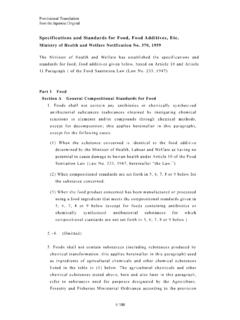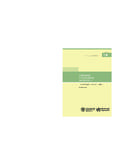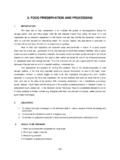Transcription of Food and Agriculture Organization World Health of the ...
1 JECFA/63/SC Summary and conclusions of the sixty-third meeting of the Joint FAO/WHO Expert Committee on food Additives (JECFA) Page 1 of 18 food and Agriculture Organization World Health of the United Nations Organization JOINT FAO/WHO EXPERT COMMITTEE ON food ADDITIVES Sixty-third meeting Geneva, 8-17 June 2004 SUMMARY AND CONCLUSIONS A meeting of the Joint FAO/WHO Expert Committee on food Additives (JECFA) was held in Geneva, Switzerland, from 8 to 17 June 2004. The purpose of the meeting was to evaluate certain food additives and ingredients, flavouring agents, and a natural constituent of food .
2 Dr John Larsen, Division of Toxicology and Risk Assessment, Danish Institute of food and Veterinary Research, S borg, Denmark, served as Chairman and Mrs Inge Meyland, Danish Institute of food and Veterinary Research, S borg, Denmark, served as Vice-Chairman. Dr Manfred Luetzow, food Quality and Standards Service, food and Nutrition Division, food and Agriculture Organization of the United Nations, and Dr Angelika Tritscher, International Programme on Chemical Safety, World Health Organization , served as joint secretaries. The present meeting was the sixty-third in a series of similar meetings.
3 The tasks before the Committee were (a) to elaborate further principles for evaluating the safety of food additives; (b) to evaluate certain food additives, ingredients, and flavouring agents; (c) to review and prepare specifications for selected food additives and flavouring agents; (d) to evaluate a natural constituent of food . The report of the meeting will appear in the WHO Technical Report Series. Its presentation will be similar to that of previous reports, namely, general considerations, comments on specific substances, and recommendations for future work.
4 An annex will include detailed tables (similar to the tables in this report) summarizing the main conclusions of the Committee in terms of acceptable daily intakes (ADIs) and other toxicological recommendations. Information on specifications for the identity and purity of certain food additives examined by the Committee will also be included. The participants in the meeting are listed in Annex 1. Further information required or desired is listed in Annex 2. General considerations, that contain information that the Committee would like to disseminate quickly are included in Annex 3.
5 Toxicological monographs or monograph addenda on most of the substances that were considered will be published in WHO food Additives Series No. 54. New and revised specifications for the identity and purity of the compounds will be published in FAO food and Nutrition Paper Series 52, Addendum 12. More information on the work of the Joint FAO/WHO Expert Committee on food Additives (JECFA) is available at: JECFA/63/SC Summary and conclusions of the sixty-third meeting of the Joint FAO/WHO Expert Committee on food Additives (JECFA) Page 2 of 18 Toxicological recommendations and information on specifications 1.
6 food additives and ingredients evaluated toxicologically food additive Specifi-cationsa Acceptable daily intake (ADI) and other toxicological recommendations Benzoyl peroxide R Treatment of whey with benzoyl peroxide at a maximum concentration of 100 mg/kg does not pose a safety concern. -Cyclodextrin - -Cyclodextrin does not pose a safety concern at the proposed use levels and resulting predicted consumption as food ingredient and food additive. The previously established ADI "not specified" for use as a carrier and stabilizer for flavours, colours, and sweeteners, as a water-solubilizer for fatty acids and certain vitamins, as a flavour modifier in soya milk, and as an absorbent in confectionery was maintained.
7 Hexose oxidase from Chondrus crispus expressed in Hansenula polymorpha N Not specifiedb Lutein from Tagetes erecta L. N 0 2 mg/kg bw (group ADI for lutein and zeaxanthin)c Peroxyacid antimicrobial solutions containing 1-hydroxyethylidene-1,1-diphosphonic acid (HEDP) Containing HEDP and three or more of the following components: peroxacetic acid, acetic acid, hydrogen peroxide, octanoic acid and peroxyoctanoic acid. The peroxy compounds in these solutions (hydrogen peroxide, peroxyacetic acid and peroxyoctanoic acid) would break down into acetic acid and octanoic acid, and small residual quantities of these acids on foods at the time of consumption would not pose a safety concern.
8 HEDP does not pose a safety concern at the levels of residue that are expected to remain on foods at the time consumption. Acetic acid R 1-Hydroxyethylidene-1,1-diphosphonic acid (HEDP) N Hydrogen peroxide R Octanoic acid (as food additive) N Steviol glycosides N, T 0 2 mg/kg bw (temporary) D-Tagatose - Not specifiedb Xylanase from Bacillus subtilis expressed in Bacillus subtilis N Not specifiedb Xylanase (resistant to xylanase inhibitor)
9 From Bacillus subtilis containing a modified xylanase gene from Bacillus subtilis N Not specifiedb Zeaxanthin N 0 2 mg/kg bw (group ADI for lutein and zeaxanthin)c a N: new specifications prepared; R: existing specifications revised; T: tentative specifications. b ADI not specified is used to refer to a food substance of very low toxicity which, on the basis of the available data (chemical, biochemical, toxicological and other) and the total dietary intake of the substance arising from its use at the levels necessary to achieve the desired effects and from its acceptable background levels in food , does not, in the opinion of the Committee, represent a hazard to Health .
10 For that reason, and for the reasons stated in the individual evaluations, the establishment of an ADI expressed in numerical form is not deemed necessary. An additive meeting this criterion must be used within the bounds of good manufacturing practice, it should be technologically efficacious and should be used at the lowest level necessary to achieve this effect, it should not conceal food of inferior quality or adulterated food , and it should not create a nutritional imbalance. c This group ADI does not apply to other xanthophyll-containing extracts with a lutein or zeaxanthin content lower than that cited in the specifications.














